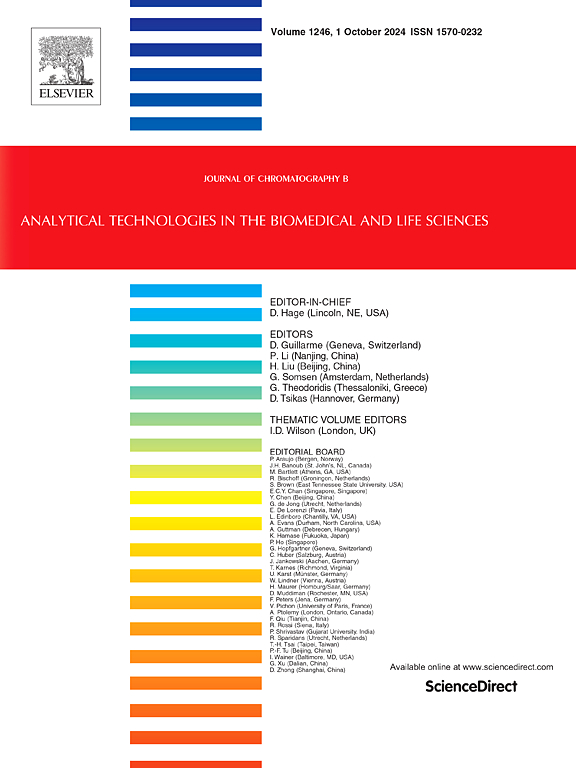A magnetic poly (methacrylic acid-co-ethylene glycol dimethacrylate) copolymer for extraction of anticonvulsants from saliva followed by high performance liquid chromatography analysis
IF 2.8
3区 医学
Q2 BIOCHEMICAL RESEARCH METHODS
引用次数: 0
Abstract
Neurological diseases like epilepsy are commonly treated with anticonvulsants, and the dosage control of these medications has been carried out with therapeutic biomonitoring, mainly in blood. Saliva is a less invasive sample, and its drug concentration is proportional to the blood fraction concentration not bound to the proteins, making it an important alternative to blood. Therefore, this study describes the synthesis of a magnetic poly (methacrylic acid-co-ethylene glycol dimethacrylate) copolymer (M-CP) and its use in magnetic dispersive solid phase extraction of primidone (PMR), phenobarbital (PB), phenytoin (PHT), and carbamazepine (CB) from saliva, followed by their determination by high performance liquid-chromatography. M-CP was synthesized in 4 steps and the material was characterized by infrared spectroscopy, scanning electron microscopy, zeta potential, and thermal analysis. The sample preparation protocol was optimized by central composite rotatable design and the optimal conditions were obtained for pH 5.78, 12.8 mg of M-CP, and 2.18 mL of diluted saliva. In the adsorption studies, the Avrami and Jovanovic models demonstrated the best fit for describing the adsorption kinetics and isotherm, respectively. The equilibrium time was reached in 60 min, and 10.96 mg g−1 was the maximum adsorption capacity. The developed method was linear (R2 > 0.99) in the range of 2 to 30 mg L−1 for PMR and PB, 1 to 20 mg L−1 for PHT, and 1 to 30 mg L−1 for CBZ. Precisions were obtained in the range of 1.35 to 19.44 %, and accuracy from −14.92 % to 18.83 %. The limits of detection ranged from 0.48 to 1.30 mg L−1, while the limits of quantification were lower than the therapeutic levels of each drug, being suitable for the method application. The developed method is simple, fast, and requires few amounts of saliva, sorbent, and solvents, being a good alternative for the therapeutic biomonitoring of anticonvulsants in saliva samples.
一种磁性聚(甲基丙烯酸-共乙二醇二甲基丙烯酸酯)共聚物,用于从唾液中提取抗惊厥药并进行高效液相色谱分析
像癫痫这样的神经系统疾病通常用抗惊厥药治疗,这些药物的剂量控制一直是通过治疗性生物监测来进行的,主要是在血液中。唾液是一种侵入性较小的样本,其药物浓度与未与蛋白质结合的血液浓度成正比,使其成为血液的重要替代品。因此,本研究合成了一种磁性聚甲基丙烯酸-共乙二醇二甲基丙烯酸酯共聚物(M-CP),并将其用于唾液中普米酮(PMR)、苯巴比妥(PB)、苯妥英(PHT)和卡马西平(CB)的磁分散固相萃取,并用高效液相色谱法对其进行测定。通过红外光谱、扫描电镜、zeta电位和热分析对合成的M-CP进行了表征。采用中心复合旋转设计优化样品制备工艺,得到pH为5.78,M-CP为12.8 mg,唾液稀释量为2.18 mL的最佳制备条件。在吸附研究中,Avrami模型和Jovanovic模型分别最适合描述吸附动力学和等温线。平衡时间为60 min,最大吸附量为10.96 mg g−1。所建立的方法是线性的(R2 >;0.99), PMR和PB在2 ~ 30mg L−1范围内,PHT在1 ~ 20mg L−1范围内,CBZ在1 ~ 30mg L−1范围内。精密度为1.35% ~ 19.44%,准确度为- 14.92% ~ 18.83%。检出限为0.48 ~ 1.30 mg L−1,定量限低于各药物的治疗水平,适用于本方法的应用。该方法简单、快速,需要的唾液、吸附剂和溶剂量少,是唾液样本中抗惊厥药物治疗性生物监测的良好选择。
本文章由计算机程序翻译,如有差异,请以英文原文为准。
求助全文
约1分钟内获得全文
求助全文
来源期刊

Journal of Chromatography B
医学-分析化学
CiteScore
5.60
自引率
3.30%
发文量
306
审稿时长
44 days
期刊介绍:
The Journal of Chromatography B publishes papers on developments in separation science relevant to biology and biomedical research including both fundamental advances and applications. Analytical techniques which may be considered include the various facets of chromatography, electrophoresis and related methods, affinity and immunoaffinity-based methodologies, hyphenated and other multi-dimensional techniques, and microanalytical approaches. The journal also considers articles reporting developments in sample preparation, detection techniques including mass spectrometry, and data handling and analysis.
Developments related to preparative separations for the isolation and purification of components of biological systems may be published, including chromatographic and electrophoretic methods, affinity separations, field flow fractionation and other preparative approaches.
Applications to the analysis of biological systems and samples will be considered when the analytical science contains a significant element of novelty, e.g. a new approach to the separation of a compound, novel combination of analytical techniques, or significantly improved analytical performance.
 求助内容:
求助内容: 应助结果提醒方式:
应助结果提醒方式:


